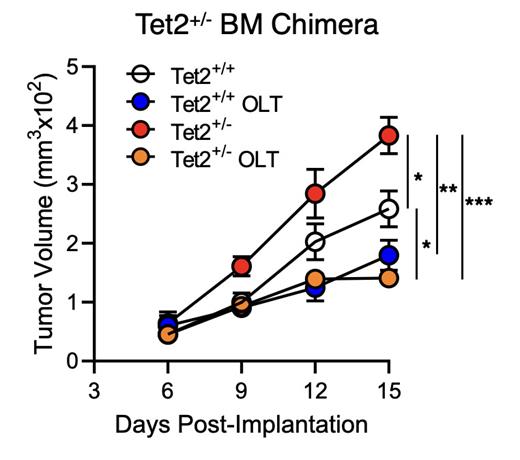Clonal hematopoiesis of indeterminate potential (CHIP) is characterized by the clonal expansion of hematopoietic stem cells possessing somatic mutations commonly associated with cancer, but with no detectable hematological cancer. Certain CHIP driver mutations, such as loss of function in Tet2 result in hyperinflammatory myeloid cells. The proinflammatory cytokine IL-1β promotes breast cancer progression and correlates with disease severity. Activation of the NLRP3 inflammasome in myeloid cells is the main source of IL-1β processing. Here, we demonstrate growth of the metastatic breast cancer cell line, E0771, in both germline and chimeric Tet2 +/- mice was 2-fold greater than that observed in Tet2 +/+ mice (Figure 1). The increased tumor burden in Tet2 +/- mice was shown to be NLRP3-dependent as Tet2 +/-mice receiving the NLRP3 inhibitor, OLT1177, exhibited significantly decreased tumor growth compared to Tet2 +/- mice with no treatment (Figure 1). Cellular composition of the tumor microenvironment was also assessed. Notably, we observed marked increases in tumor-infiltrating granulocytes in the Tet2 +/- mice. This observation was consistent with elevated serum cytokines associated with neutrophil recruitment and activation. Next, considering NLRP3 inflammasome activation is tightly linked to metabolic alterations, we sought to characterize the metabolic profile of Tet2 +/- myeloid cells. To start, global metabolic analysis revealed increased abundance of metabolites from glycolysis and pentose phosphate pathway in Tet2 +/- myeloid cells compared to Tet2 +/+ myeloid cells. Consistent with the metabolic demands of a hyperinflammatory phenotype, Seahorse Flux assays revealed significantly increased ECAR (glycolysis) and OCR (pentose phosphate pathway) as measured at baseline in Tet2 +/- myeloid cells compared to Tet2 +/+ myeloid cells. Lastly, to confirm whether metabolic alterations drive the hyperinflammatory phenotype in Tet2 +/- myeloid cells, we assessed cytokine production after LPS stimulation in Tet2 +/-and Tet2 +/+ myeloid cells treated with 2-DG (glycolysis inhibitor) or 6-AN (pentose phosphate pathway inhibitor). Expectedly, Tet2 +/- myeloid cells produced significantly more IL-1β, IL-6, TNFα and IL-18 compared to Tet2 +/+ myeloid cells after LPS stimulation. LPS induced IL-1β and IL-6 production was significantly decreased for both genotypes after 2-DG and 6-AN treatment. Importantly, LPS induced TNFα and IL-18 only decreased after 2-DG and 6-AN treatment in Tet2 +/- myeloid cells suggesting metabolic changes associated with loss of TET2 affect not only NLRP3 priming but TNFα secretion as well. Overall, these studies demonstrate how TET2-driven CHIP alters the tumor microenvironment in breast cancers through aberrant NLRP3 activation and characterizes the underlying metabolic alterations subsequent to loss of TET2, offering further mechanistic insight into the hyperinflammatory phenotype in myeloid cells associated with TET2-driven CHIP.
Figure 1. Tet2+/- driven breast cancer progression is NLRP3 activation-dependent.
Experimental designs; BM chimeras were generated by transplanting 75%WT:25%Tet2+/+ or Tet2+/- mixed BM, mice were orthotopically implanted with E0771 breast tumors and given standard or OLT1177 diet (OLT). Tumor growth curve from Tet2+/+(WT) or Tet2 +/- chimeric mice implanted with E0771 cells receiving standard or OLT1177 diet(OLT) (N=10, two independent experiments). ***p<0.001, **p<0.01, *p<0.05.
Disclosures
Tengesdal:Olatec Therapeutics: Consultancy. Marchetti:Olatec Therapeutics: Consultancy. Dinarello:Olatec Therapeutics: Current equity holder in private company.


This feature is available to Subscribers Only
Sign In or Create an Account Close Modal